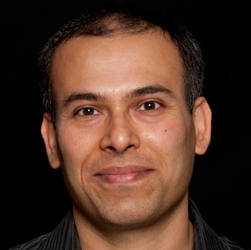
Beyond the tremendous level of activity around big data (data science, machine learning, data analytics…take your pick of the term) in research circles, I wanted to peek into some of the use cases for its adoption in the industries that deal with physical things, as opposed to digital objects, and draw some inferences about what conditions help adoption of the research that we do in academic circles.
What's Driving the Convergence?
The convergence of Internet of Things (IoT) and big data is not surprising at all. Industries with lots of small assets (think pallets on a factory floor) or several large assets (think jet engines) have been putting many many sensors on them. These sensors generate unending streams of data, thus satisfying two of the three V's of big data right there: velocity and volume. Next time you are on a plane and are lucky to be next to the wings, look underneath the wings and you will see an engine — if it is Rolls Royce or GE, it may even have been designed or manufactured in our backyard in Indiana. Engines like these are generating 10 GB/s of data that is being fed back in real time to some onboard storage or more futuristically streamed to the vendor's private cloud. This is one piece of the IoT-big data puzzle, the data generation and transmission. This is the more mature part of the adoption story. The more evolving part of the big data story is the analysis on all this data to make actionable decisions, and that, too, in double-quick time.
Use Cases for Collecting Big Data
The second part of this story is in the analysis of all this data to generate actionable information. Talking to my industrial colleagues, there are five major use cases for such analysis:
- Predictive maintenance/downtime minimization: Know when a component is going to fail before it fails, and swap it out or fix it.
- Inventory tracking/loss prevention: Many industries of physical analog things have lots of moving parts; again, think of pallets being moved around. They want to track where a moving part is now and where all it has been.
- Asset utilization: Get the right component to the right place at the right time so that it can be used more often.
- Energy usage optimization: Self-explanatory, and becoming increasingly important as the moral and dollar imperative of reducing energy usage becomes more pressing.
- Demand forecasting/capacity planning: Self-explanatory, but firms seem to be getting better at doing this at shorter time scales. Way back in 1969, the U.S. Federal Aviation Administration (FAA) was already predicting air traffic demands on an annual basis; now think of predicting the demand for the World Cup soccer jerseys depending on which country is doing how well on a daily basis.
Factors Helping Adoption of Academic Research
Academia has been agog about this field of big data for, well, …seems like forever. We academics thirst for real use cases and real data and this field exemplifies this more than most. We need to be able to demonstrate that our algorithm and its instantiation in a working software system delivers value to some application domain. How do we do that? There is, of course, a lot of pavement pounding and trying to convince our industrial colleagues. Again talking to a spectrum, some factors seem to recur frequently. These are not universal across application domains, not by a long shot, but they are not one-off, either.
- Horizontal and vertical. There is a core of horizontal algorithmic rigor that cuts across the specifics of the application, but this is combined quite intricately with application-specific design choices. We can snarkily call them "hacks," but they are supremely important piece of the puzzle. This means we cannot build the horizontal and throw it across the fence, but rather have to go the distance of understanding the application context and the vertical.
- Interpretability. While the ardent devotees at the altar of big data are willing to accept the output of an algorithm like the Oracle of Delphi, many of my industrial colleagues in the business of building physical objects small or large are cagey about such blind faith. Thus, our algorithms must provide some insights or knobs to play "what if" scenarios. This sometimes runs at odds with building super-powerful models and algorithms, but it is our dictate from the real world to make smart tradeoffs.
- Streaming data and warehouse data. My colleagues seem to want the yin and the yang on the same platform. The data analytics routine should be capable of handling data as it streams past, as well as the old data from years of operation that is sitting in a musty digital warehouse. This speaks to the need to extract value from the wealth of historical data, as well as making agile decisions on the streams of data being generated now.
- Unsupervised learning. This is entering technical-jargonland, but basically this means we do not want to have to recruit armies of people to label data before we can let any algorithm loose on the data. That takes time, effort, legal wrangling, and we are never completely sure of the quality of labeling. So we would, whenever we can, use unsupervised learning which does not rely on a deluge of labeled data.
In Conclusion
I think the domains of big data and IoT are destined to mutually propel each other. The first makes the latter appear smarter, even when the IoT system is built out of lots of small dumb devices. The latter provides the former with fruitful challenging technical problems. Big data algorithms here have to become small, run with a small footprint, a gentle giant in the land of many, many devices.
Saurabh Bagchi is a professor of electrical and computer engineering, and of computer science, at Purdue University, where he leads a university-wide center on resilience called CRISP. His research interests are in distributed systems and dependable computing, while he and his group have the most fun making and breaking large-scale usable software systems for the greater good.



Join the Discussion (0)
Become a Member or Sign In to Post a Comment